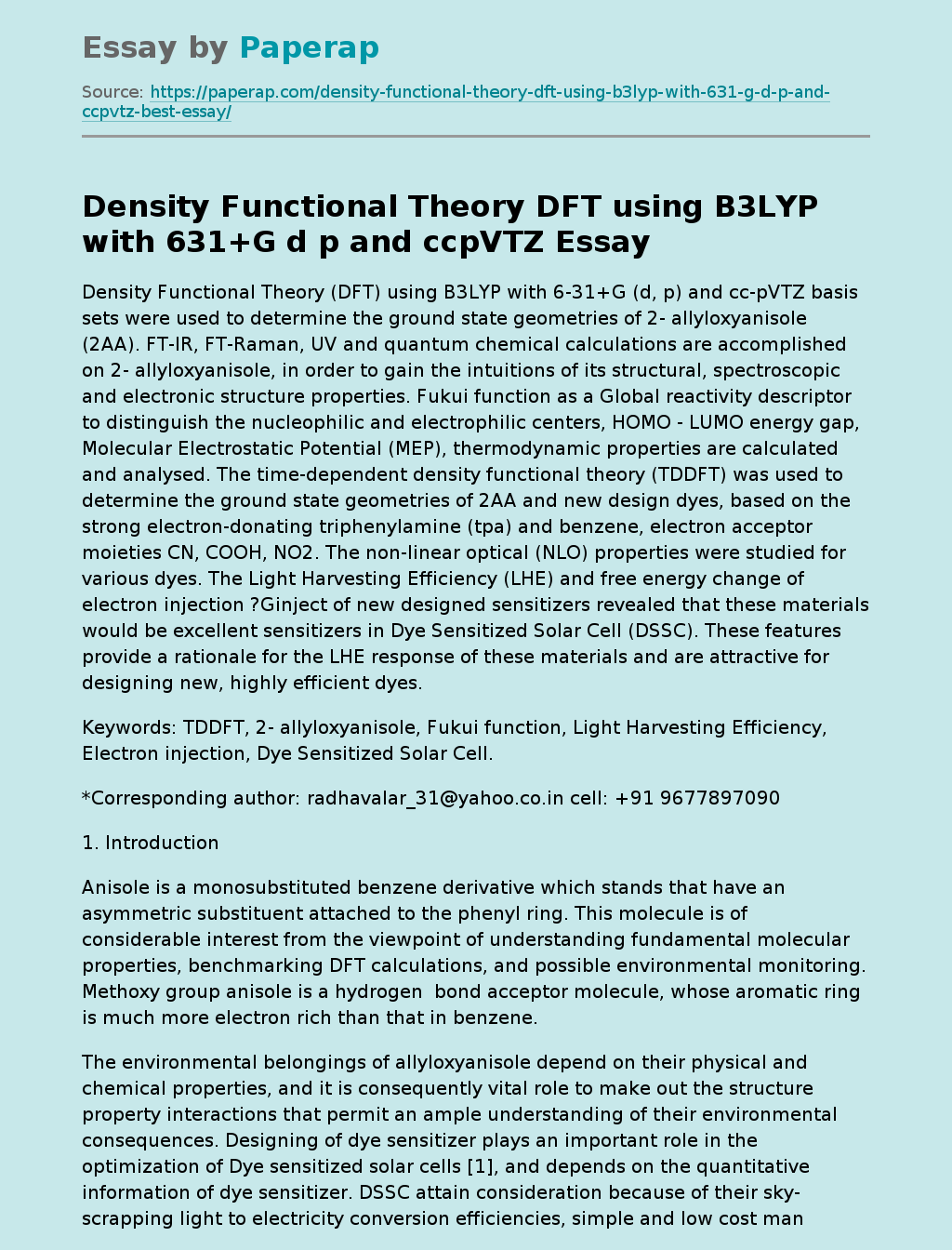Density Functional Theory (DFT) using B3LYP with 6-31+G (d, p) and cc-pVTZ basis sets were used to determine the ground state geometries of 2- allyloxyanisole (2AA). FT-IR, FT-Raman, UV and quantum chemical calculations are accomplished on 2- allyloxyanisole, in order to gain the intuitions of its structural, spectroscopic and electronic structure properties. Fukui function as a Global reactivity descriptor to distinguish the nucleophilic and electrophilic centers, HOMO – LUMO energy gap, Molecular Electrostatic Potential (MEP), thermodynamic properties are calculated and analysed.
The time-dependent density functional theory (TDDFT) was used to determine the ground state geometries of 2AA and new design dyes, based on the strong electron-donating triphenylamine (tpa) and benzene, electron acceptor moieties CN, COOH, NO2. The non-linear optical (NLO) properties were studied for various dyes. The Light Harvesting Efficiency (LHE) and free energy change of electron injection ?Ginject of new designed sensitizers revealed that these materials would be excellent sensitizers in Dye Sensitized Solar Cell (DSSC). These features provide a rationale for the LHE response of these materials and are attractive for designing new, highly efficient dyes.
Keywords: TDDFT, 2- allyloxyanisole, Fukui function, Light Harvesting Efficiency, Electron injection, Dye Sensitized Solar Cell.
*Corresponding author: [email protected] cell: +91 9677897090
1. Introduction
Anisole is a monosubstituted benzene derivative which stands that have an asymmetric substituent attached to the phenyl ring. This molecule is of considerable interest from the viewpoint of understanding fundamental molecular properties, benchmarking DFT calculations, and possible environmental monitoring. Methoxy group anisole is a hydrogen bond acceptor molecule, whose aromatic ring is much more electron rich than that in benzene.
The environmental belongings of allyloxyanisole depend on their physical and chemical properties, and it is consequently vital role to make out the structure property interactions that permit an ample understanding of their environmental consequences. Designing of dye sensitizer plays an important role in the optimization of Dye sensitized solar cells [1], and depends on the quantitative information of dye sensitizer. DSSC attain consideration because of their sky-scrapping light to electricity conversion efficiencies, simple and low cost manufacturing [2-4]. The sensitizer is a crucial element in DSSC, which improves the power conversion efficiency and increase the stability of the devices. At present a moderately green solvent, anisole have been successfully applied to process organic/polymer solar cells [5]. From this 2-Allyloxyanisole preferably carry out to make good dye sensitizer.
In most of the organic sensitizers presence of donor bridge – acceptor (DBA) moieties is significant to get better performance of the photo induced intramolecular charge transfer. During electronic transition charge transfer depends on the conjucation across the donor and anchoring groups. Efficiency of organic sensitizers decreases due to dye aggregation and charge recombination [6]. It has been established that the triphenylamine (TPA) [7] derivatives as electron donor and cyanoacetic acid moiety as electron acceptor are better options to improve the efficiency [6]. It is estimated that TPA can restrain the cationic charge from the semiconductor surface therefore block the recombination. TPA also has a characteristic hindrance that can put off undesirable dye aggregation at the semiconductor surface [8]. To model and design efficient metal-free sensitizers for DSSC, suitable DBA system are needed whose properties can be altered by applying the drivable structural modifications.
Due to these applications and the unswerving properties of anisole, a complete vibrational study of 2-Allyloxyanisole (2AA) and newly designed 2AA base dyes by the substitution of benzene and TPA moiety in 2AA dye as donors and cyanoacetic acid moiety, NO2 and CN as electron acceptor is undertaken. The quantum chemical investigation has been performed to explore the optical and electronic properties of a series of different compounds based on allyloxyanisole. The theoretical knowledge of HOMO and LUMO energy levels of the dye compounds is helpful to understand the efficiency of organic solar cells and also useful to synthesis of new efficient dye molecules for DSSC.
Density Functional Theory DFT using B3LYP with 631+G d p and ccpVTZ. (2019, Nov 20). Retrieved from https://paperap.com/density-functional-theory-dft-using-b3lyp-with-631-g-d-p-and-ccpvtz-best-essay/

